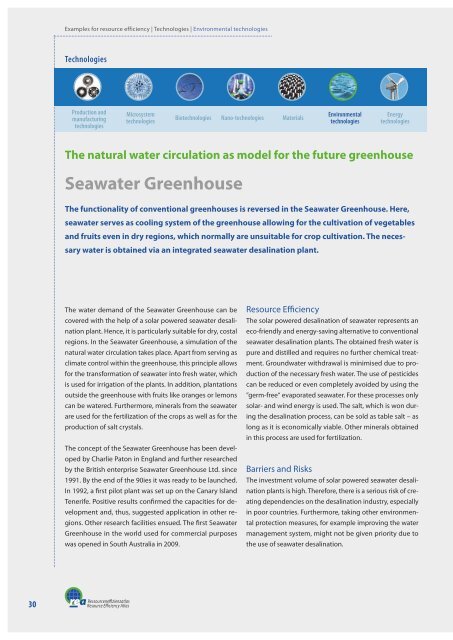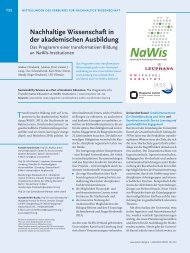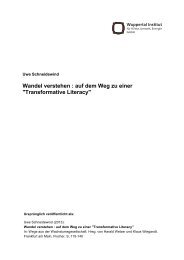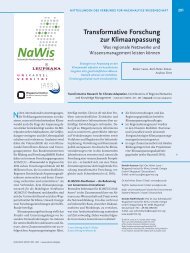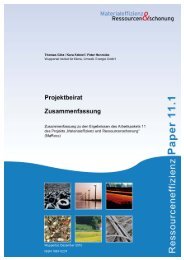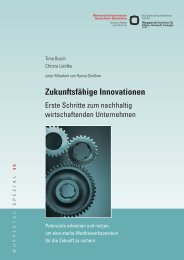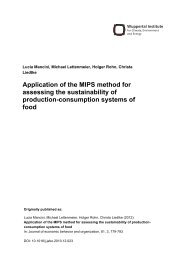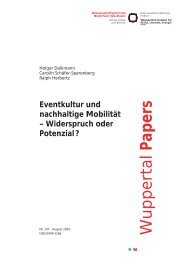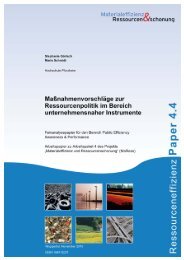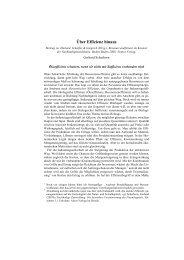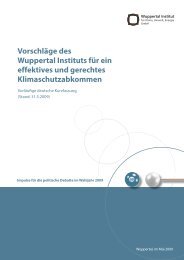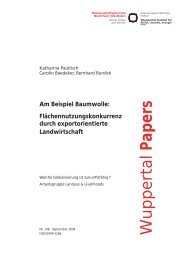Resource Efficiency Atlas - Publication Server of the Wuppertal ...
Resource Efficiency Atlas - Publication Server of the Wuppertal ...
Resource Efficiency Atlas - Publication Server of the Wuppertal ...
Create successful ePaper yourself
Turn your PDF publications into a flip-book with our unique Google optimized e-Paper software.
30<br />
Examples for resource efficiency | Technologies | Environmental technologies<br />
Technologies<br />
Production and<br />
manufacturing<br />
technologies<br />
The natural water circulation as model for <strong>the</strong> future greenhouse<br />
Seawater Greenhouse<br />
The functionality <strong>of</strong> conventional greenhouses is reversed in <strong>the</strong> Seawater Greenhouse. Here,<br />
seawater serves as cooling system <strong>of</strong> <strong>the</strong> greenhouse allowing for <strong>the</strong> cultivation <strong>of</strong> vegetables<br />
and fruits even in dry regions, which normally are unsuitable for crop cultivation. The necessary<br />
water is obtained via an integrated seawater desalination plant.<br />
The water demand <strong>of</strong> <strong>the</strong> Seawater Greenhouse can be<br />
covered with <strong>the</strong> help <strong>of</strong> a solar powered seawater desalination<br />
plant. Hence, it is particularly suitable for dry, costal<br />
regions. In <strong>the</strong> Seawater Greenhouse, a simulation <strong>of</strong> <strong>the</strong><br />
natural water circulation takes place. Apart from serving as<br />
climate control within <strong>the</strong> greenhouse, this principle allows<br />
for <strong>the</strong> transformation <strong>of</strong> seawater into fresh water, which<br />
is used for irrigation <strong>of</strong> <strong>the</strong> plants. In addition, plantations<br />
outside <strong>the</strong> greenhouse with fruits like oranges or lemons<br />
can be watered. Fur<strong>the</strong>rmore, minerals from <strong>the</strong> seawater<br />
are used for <strong>the</strong> fertilization <strong>of</strong> <strong>the</strong> crops as well as for <strong>the</strong><br />
production <strong>of</strong> salt crystals.<br />
The concept <strong>of</strong> <strong>the</strong> Seawater Greenhouse has been developed<br />
by Charlie Paton in England and fur<strong>the</strong>r researched<br />
by <strong>the</strong> British enterprise Seawater Greenhouse Ltd. since<br />
1991. By <strong>the</strong> end <strong>of</strong> <strong>the</strong> 90ies it was ready to be launched.<br />
In 1992, a first pilot plant was set up on <strong>the</strong> Canary Island<br />
Tenerife. Positive results confirmed <strong>the</strong> capacities for development<br />
and, thus, suggested application in o<strong>the</strong>r regions.<br />
O<strong>the</strong>r research facilities ensued. The first Seawater<br />
Greenhouse in <strong>the</strong> world used for commercial purposes<br />
was opened in South Australia in 2009.<br />
Ressourceneffizienzatlas<br />
<strong>Resource</strong> <strong>Efficiency</strong> <strong>Atlas</strong><br />
Microsystem<br />
technologies<br />
Biotechnologies Nano-technologies Materials<br />
Environmental<br />
technologies<br />
Energy<br />
technologies<br />
<strong>Resource</strong> <strong>Efficiency</strong><br />
The solar powered desalination <strong>of</strong> seawater represents an<br />
eco-friendly and energy-saving alternative to conventional<br />
seawater desalination plants. The obtained fresh water is<br />
pure and distilled and requires no fur<strong>the</strong>r chemical treatment.<br />
Groundwater withdrawal is minimised due to production<br />
<strong>of</strong> <strong>the</strong> necessary fresh water. The use <strong>of</strong> pesticides<br />
can be reduced or even completely avoided by using <strong>the</strong><br />
’’germ-free“ evaporated seawater. For <strong>the</strong>se processes only<br />
solar- and wind energy is used. The salt, which is won during<br />
<strong>the</strong> desalination process, can be sold as table salt – as<br />
long as it is economically viable. O<strong>the</strong>r minerals obtained<br />
in this process are used for fertilization.<br />
Barriers and Risks<br />
The investment volume <strong>of</strong> solar powered seawater desali-<br />
nation plants is high. Therefore, <strong>the</strong>re is a serious risk <strong>of</strong> creating<br />
dependencies on <strong>the</strong> desalination industry, especially<br />
in poor countries. Fur<strong>the</strong>rmore, taking o<strong>the</strong>r environmental<br />
protection measures, for example improving <strong>the</strong> water<br />
management system, might not be given priority due to<br />
<strong>the</strong> use <strong>of</strong> seawater desalination.


